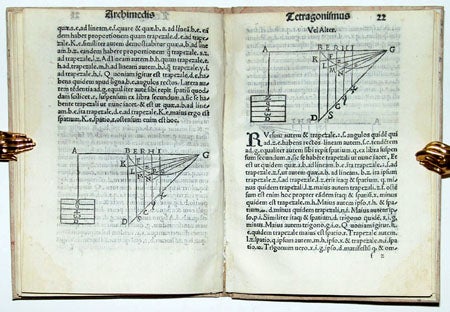
Tetragonismus id est circuli quadratura per Ca(m)panu(m), Archimede(m) Syracusanu(m) atq(ue) boetium mathematicae perspicacissimos adinuenta.
4to. [20 x 14.5 cm], 32 ff. with elaborate woodcut on title, woodcut initials and diagrams throughou-t. Bound in later marbled paper over boards. Title and first 3 leaves stained at outer margin, scattered light waterstaining, cropped at top margin affecting running head and foliation, a handful of leaves reinforced in the gutter, repaired tear on ff. 30-31 not affecting legibility. Printed on heavy paper; overall very good.
First published Latin edition of De Mensura Circuli and De Quadratura Parabolae, containing Archimedes' application of the method of exhaustion (the early form of integration) and the earliest theoretical calculation of p; apart from Valla's excerpts of 1501, THE FIRST PRINTED LATIN TEXTS OF ARCHIMEDES (Rose, p. 50).
The brief treatise On the Measurement of the Circle contains "one of the most popular results of [Archimedes?] mathematical investigations" (Dijksterhuis, p. 222). Archimedes calculated the ratio between the circumference and the diameter of a circle (not called p until early modern times) as being less than 31/7 and greater than 310/71. The average of these two bounds is 3.1418, an error of about 0.0002. Archimedes obtained his sophisticated estimate for p by circumscribing and inscribing a circle with regular polygons having 96 sides.
"In the course of this proof [of p] Archimedes showed that he had an accurate method of approximating the roots of large numbers. It is also of interest that he there gave an approximation for √3, namely 1351/780 > √3 > 265/153. How he computed this has been much disputed." (DSB I.222) All of his calculations were obtained using not algebraic or trigonometrical notation but purely geometrical means, and without decimal notation.
Of the surviving Archimedean works, De Quadratura Parabolae is believed to have been written second. In it, Archimedes employed statical procedures in the solution of geometrical problems and the demonstration of theorems (DSB II.219). He demonstrated the quadrature of the parabola (as it would later become known) by purely geometric methods, and found the area of a segment of a parabola cut off by any chord. The tract opens with five propositions on properties of the orthotome, followed by eight propositions in which equalities and inequalities about plane figures suspended on a balance are enunciated (Dijksterhuis, p. 336).
Gaurico based his translations of De Mensura Circuli and De Quadratura Parabolae on a manuscript of Moerbeke's 1269 translation (Madrid MS 9119). Gaurico (1476-1588) reportedly took a doctorate in arts at Padua in 1502 and the preface to the Tetragonismus is dated from Padua, 1503. He went on to publish an edition of Pecham's Perspectiva Communis, and Trapezuntius's translation of the Almagest (Venice, 1528). Gaurico's contemporary reputation stemmed from his astrological prognostications, for which he earned a bishopric from Paul III. Rose suggests that Gaurico may have met Copernicus at Padua, as they were both at the university in the early years of the 16th century, and would have shared a common interest in Ptolemy and Archimedes (Rose, p. 120).
Gaurico's Tetragonismus, which concludes with a short commentary by Boethius on circles, includes a substantial chapter credited to Campanus of Novara that is also entitled Tetragonismus idest circuli quadratura.
* Riccardi I.40; Clagett, Archimedes in the Middle Ages (Wisconsin, 1964), II.72; Proctor-Isaac 12,551; Essling 1388; Hollis *OGC Ar25E E503; s.v. PMM 72; DSB III.23-29.
Price: $27,000.00
